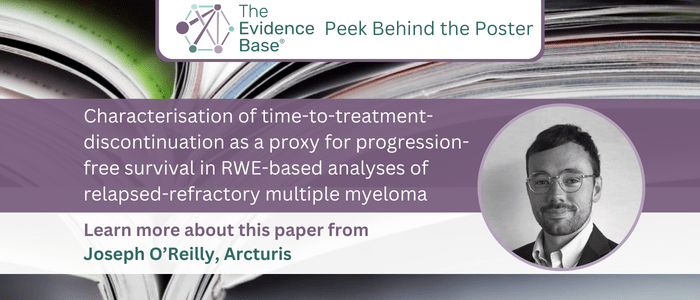Peek Behind the Poster: Characterisation of time-to-treatment-discontinuation as a proxy for progression-free survival in RWE-based analyses of relapsed-refractory multiple myeloma

 External control arms (ECAs) can overcome some of the hurdles in clinical research where the gold standard randomized controlled trial is infeasible or impractical, such as in rare diseases or in precision oncology, where evidence from single-arm trials is being increasingly used to make regulatory decisions. Often, real-world data (RWD) collected for use in ECAs does not equate to the data captured in clinical trials, making the generation of comparative clinical evidence a challenge. Research is therefore vital to explore alternative endpoints and validate their use as clinically meaningful outcome measures.
External control arms (ECAs) can overcome some of the hurdles in clinical research where the gold standard randomized controlled trial is infeasible or impractical, such as in rare diseases or in precision oncology, where evidence from single-arm trials is being increasingly used to make regulatory decisions. Often, real-world data (RWD) collected for use in ECAs does not equate to the data captured in clinical trials, making the generation of comparative clinical evidence a challenge. Research is therefore vital to explore alternative endpoints and validate their use as clinically meaningful outcome measures.
In this interview, we speak with Joseph O’Reilly (Arcturis, UK) about his poster presented at ISPOR Europe 2023 (November 12–15, 2023, Copenhagen, Denmark) entitled, ‘Characterisation of time-to-treatment-discontinuation as a proxy for progression-free survival in real-world-evidence based analyses of relapsed-refractory multiple myeloma.’
Please could you introduce yourself and your organization?
I am a lead medical statistician at Arcturis, where I have worked for just under two years. My academic training was in Bayesian statistics and epidemiology, and I joined Arcturis to put my training to use in helping expedite patient access to effective novel therapies. Arcturis uses rich, longitudinal RWD to support the development and regulatory approval of new therapies through the generation of evidence that can improve patient outcomes, streamline the pharmaceutical development process, and inform policy decisions. In my role, I design and implement statistical analyses that leverage the Arcturis real-world datasets to characterize therapy pathways, describe the distribution of disease, and estimate the comparative effect of competing therapies.
In your research presented at ISPOR Europe 2023 [1], you look at time-to-treatment-discontinuation as a proxy for progression-free survival (PFS) in real-world ECA studies. Why is it important to explore new endpoints in RWD studies?
The randomized clinical trial will always be the gold standard when comparing the effect of two or more therapies, but, in some cases, it may be unethical or not feasible to perform a multi-armed trial. It is also often the case that evidence presented to health technology assessment (HTA) bodies is generated in a trial in which the control therapy may differ from the standard of care that is required for the HTA assessment. In such cases, an ECA can offer an estimate of comparative effectiveness in which subjects from a real-world dataset form a control cohort that is compared to the intervention arm of a trial.
Unfortunately, data generated as part of routine care may not allow for assessment of the same outcomes that are used in a trial, as many of the required tests are too invasive or expensive to be performed regularly outside of a trial setting. It is also the case that certain RWD sources are restricted to therapy exposure interval information only, precluding the assessment of any endpoint that relies on regular biochemistry testing. A consequence of this is that it may not be possible to assess the same endpoints in both a trial arm and an ECA. Time to treatment discontinuation (TTD) offers a potential proxy for disease progression in cases where assessment of progression is not possible for a given RWD source. The utility of proxy endpoints for comparative effectiveness studies depends on their ability to be compared to traditional trial endpoints. Currently, it is unclear how well proxy measures, such as TTD, map to disease progression in multiple myeloma when disease progression is primarily determined through longitudinal biochemistry data.
 Want to learn more about external control arms?
Want to learn more about external control arms?
Watch our interview with Dr Lewis Carpenter (Artcuris).
What are the main objectives of your study and what challenges do they overcome?
Our study was designed to assess the validity of TTD as a proxy for progression-free survival (PFS) in a real-world dataset of multiple myeloma patients across several scenarios. We aimed to characterize the time delay between progression events and subsequent treatment discontinuation events amongst a cohort of patients with relapsed and refractory multiple myeloma who were treated with either pomalidomide and dexamethasone or daratumumab. We characterized the distribution in the delay between progression and treatment discontinuation by both therapy type and quantiles of time to progression. This approach allowed us to investigate whether the suitability of TTD as a proxy for PFS was constant across key patient characteristics, which may introduce bias into analysis if not accounted for.
To meet the objectives of this study we needed to construct a cohort of individuals with relapsed and refractory multiple myeloma who were similar to clinical trial populations. We used the inclusion criteria from the SIRIUS and GEN501 single-armed daratumumab studies to allow us to construct a group of individuals who had received either pomalidomide and dexamethasone or daratumumab at the same point in their treatment pathway.
How was the Arcturis dataset used in the study?
The Arcturis dataset covers nearly 7000 individuals with multiple myeloma in England and Scotland, but the population of patients who are relapsed and refractory represents only a proportion of this group. Assessment of multiple inclusion criteria from the trials required comprehensive information for each cohort member across several domains, including disease history, therapy history, and renal, hepatic, and bone marrow function at baseline.
As the Arcturis dataset captures the majority of data types required to assess disease progression, we were able to build a real-world measure of PFS based on biochemistry tests. To construct TTD, we passed disparate systemic anticancer therapy datasets through the Arcturis MM line of therapy algorithm. This approach allows us to consolidate several sources of therapy data to construct a coherent and logically consistent sequence of therapy regimens for each patient, defined by a start date, a stop date, and a set of administered therapeutic agents. We also collected several confounding covariates at baseline for the cohort, to allow us to perform subsequent adjusted comparative effectiveness analyses using either PFS or TTD as the outcome in the ECA.
What did the study show?
We built a cohort of 291 patients treated with either pomalidomide or daratumumab that were similar to the SIRIUS and GEN501 clinical trials. We found that there was often a large disparity between PFS and TTD, and that the relationship between PFS and TTD was not homogenous across therapy type and quantiles of time to progression. When we performed weighted comparative effectiveness analyses, we found that using TTD as a proxy for PFS may result in estimated treatment effects that are diminished compared to those obtained when PFS had been derived from longitudinal biochemistry tests in the real-world ECA.
What implications do these results have and are you looking to build on this research?
Our study demonstrates that the suitability of TTD as a proxy for PFS in ECA analyses depends on context, and any application of TTD as a PFS proxy must consider underlying aspects of the clinical decision-making process, which may lead to certain groups of patients remaining on treatment after progression. This means that if different processes result in patients in the ECA remaining on treatment after progression for a different time-period than in the trial, then any comparison will be influenced by this bias if TTD is used as a proxy for PFS. For multiple myeloma, this highlights the importance of having access to longitudinal biochemistry tests to help bridge the gap between PFS derived in the clinical trial, and those defined from RWD sources.
This study focuses on one specific disease area, and the suitability of TTD as a proxy for PFS is likely to vary across diseases and indications; therefore, we intend to expand this research to further disease areas to better characterize the wider validity of TTD as a PFS proxy.
Disclosures:
The opinions expressed in this feature are those of the interviewee/author and do not necessarily reflect the views of The Evidence Base®.
Sponsorship for this interview was provided by Arcturis. For more information on Arcturis services, click here.







